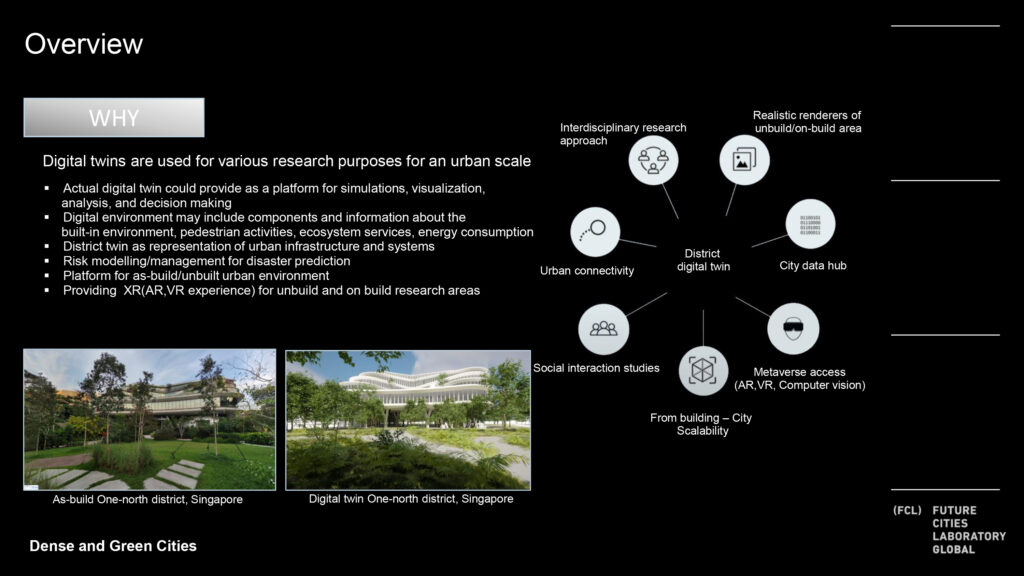In our research module, we harness the transformative power of digital twin technology to consolidate our extensive urban research. At the core of our project, we carefully code and transform complex 3D models into digital twins. This process is carefully followed for three key case studies: One-North, Jurong Westgate and Punggol Digital District. Our research spans multiple dimensions, including architecture, sociocultural influences, environmental sustainability and economic dynamics, all seamlessly merging within our sophisticated digital platform. This synthesis creates a unified space for comprehensive analysis and research. [Figure 1]

Figure 1, Digital Twin benefits
Our holistic approach allows us to conduct a thorough and in-depth assessment of our research, making it easier to test and cross-check our findings. We use the versatile Unreal Engine, an advanced and highly adaptable tool that allows us to create dynamic digital environments enriched by virtually limitless sources of artificial data. The capabilities of Unreal Engine offer us different avenues and opportunities for exploration, expanding our ability to explore urban development in innovative ways. [Figure 2]

Figure 2, Sustainable digital district
The digital twin platform offers a variety of capabilities that serve as the basis for modelling, visualization, analysis and decision making. This digital environment includes a wide range of components and information, including data on the built environment, pedestrian activity, ecosystem services and energy consumption. The Twin District serves as a representation of the city’s infrastructure and systems, allowing risk modelling and management to predict natural disasters. It also serves as a universal platform for both built and unbuilt urban environments, providing valuable sources of synthetic data for in-depth research and analysis. [Figure 3]

Figure 3, Synthetic data pipeline
Our digital twin technology stands as a transformative tool, offering a gateway to immersive Extended Reality (XR) experiences, encompassing both Augmented Reality (AR) and Virtual Reality (VR) realms. These experiences serve as a dynamic bridge to connect with both the unbuilt and built research areas we explore. Through AR and VR, we transcend the traditional boundaries of research, providing users with the opportunity to step into the heart of urban environments, whether they exist only in our imagination or have already taken shape in the real world.
This innovative approach not only amplifies the accessibility of our research findings but also elevates engagement to a whole new level. As our digital twin application takes center stage, it becomes an intrinsic component of the FUTURE CITIES LAB GLOBAL engagement platform. This seamless integration significantly enhances our outreach and facilitates effective collaboration. It allows us to bridge geographical distances and connect with other research clusters and modules, creating a dynamic and interactive environment for the collective exploration of the urban landscapes of tomorrow.
In addition, our study uses cloud web services, with Amazon Web Services (AWS) playing a key role. AWS serves as the backbone of our online presence, providing us with a robust infrastructure to host, process, and share our digital twins’ data. This integration seamlessly transforms our digital twin platform into a dynamic virtual laboratory and studio with the ability to host interactive simulations and immersive experiences. [Figure 4]

Figure 4, Realistic pre-exhibition content studio and hall
This sophisticated integration pushes the boundaries of urban research by offering a highly interactive and accessible platform for exploring our findings. Users can access our digital twin environments, participate in real-time simulations, and immerse themselves in the complex urban landscapes we study. AWS not only ensures the scalability and reliability of our platform, but also reinforces our commitment to pushing the boundaries of urban research and making it accessible to a wider audience.
